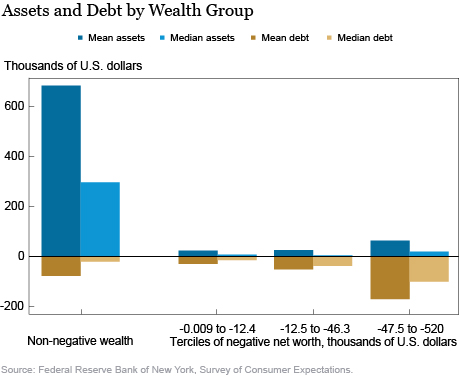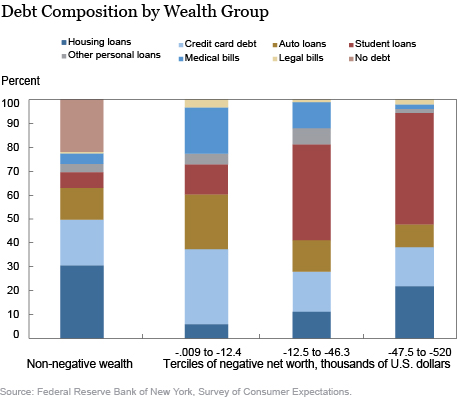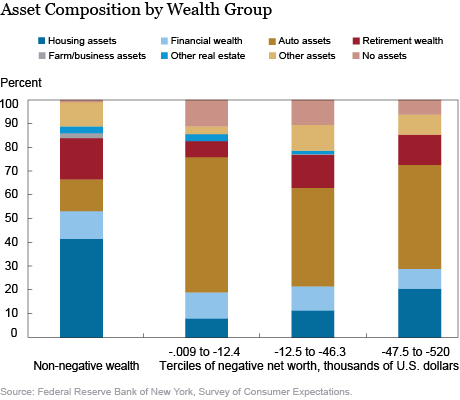Editors’ note: Some numbers related to the relative exposure of households to credit card debt and housing assets have been corrected. (August 2)

At some point in its life a household’s total debt may exceed its total assets, in which case it has “negative wealth.” Even if this status is temporary, it may affect the household’s ability to save for durable goods, restrict access to further credit, and may require living in a state of limited consumption. Detailed analysis of the holdings of negative-wealth households, however, is a topic that has received little attention. In particular, relatively little is known about the characteristics of such households or about what drives negative wealth. A better understanding of these factors could also prove valuable in explaining and forecasting the persistence of wealth inequality. In this post, we take advantage of a special module of the Survey of Consumer Expectations to shed light on this issue.
The Survey of Consumer Expectations (SCE), which was introduced in 2013 and uses a monthly rotating survey panel of roughly 1,300 respondents, focuses on collecting subjective expectations about the economy and the respondents’ behavior. As part of the SCE, a special module on household finance is fielded once a year. This module collects detailed data on the composition of respondents’ financial assets and debt, as well as their expectations about how these might change in the future. The special household finance survey has been conducted twice, in August 2014 and in August 2015. The micro-data from the 2014 module has just been released on the SCE website. The analysis conducted in this post is based on the August 2015 module.
The special module asks respondents about their finances on a multitude of dimensions. This information is used to construct a measure of the total assets and total debt that a head of household and his or her partner may have. Our measures of assets and liabilities closely mirror the measure of wealth derived in the Survey of Consumer Finances (SCF), a nationally representative triennial survey that asks respondents for detailed financial data. Notably, our measure of wealth excludes any human capital—such as education, as well as Social Security and defined-benefit-pension wealth.
With respect to assets, we ask respondents how much money is in their defined contribution plan(s)—including 401(k), 403(b), 457 or thrift savings plans—and Individual Retirement Arrangement accounts, which cover the most common channels through which Americans save for retirement. We also ask the respondents about their total savings and investments, such as money in their checking accounts, stocks, and other financial instruments they may possess. Homeowners are asked to self-appraise the current value of their home. Finally, we ask for self-appraised valuations of any additional land, businesses, vehicles, or other assets the respondent’s household may own. The measure of total assets is then the sum of financial wealth, retirement wealth, home value, and other assets.
With respect to debt, we ask respondents about their home mortgages and home equity lines of credit, as well as nonhousing personal debt in categories such as credit card, student loans, and auto loans, among others. The sum of all these debts constitutes our measure of total debt. We classify households as having negative wealth if their total debt exceeds their total assets, according to our measurements.
We estimate that 15.1 percent of the households in the U.S. population have net wealth less than or equal to zero, while 14.0 percent have strictly negative wealth. Because of differences in measurement—such as in determining who is included as a household member—estimates vary across surveys and also vary somewhat over time. For example, the share of households with non-positive wealth was estimated to be 18.1 percent in the 2011 panel of the Survey of Income and Program Participation, 12.9 percent in the 2013 Survey of Consumer Finances, and 19.4 percent in the 2013 Panel Study of Income Dynamics. Our 2015 SCE estimate of the share of households with negative wealth falls within the range observed.
What are the characteristics of households with negative wealth? We find that the heads of such households are younger than their counterparts in households with non-negative wealth—an average age of 43 compared to 51. They are also slightly less likely to have a college or postgraduate degree—43 percent and 12 percent, compared with 45 percent and 15 percent, respectively. Moreover, we find the association between having negative wealth and the head of household’s age to be stronger for those with a college degree and especially so for those with postgraduate degrees. These results are consistent with standard life-cycle models of consumption and savings, which predict that agents smooth the marginal utility of consumption by incurring debt—for instance, student loan or credit card—when young and then steadily increasing savings until retirement. In particular, those models predict that young and educated households might have negative wealth as their incomes will likely grow with age so that they will be repaying what they have borrowed when young.
Consistent with intuition, households with negative wealth have much lower average annual incomes than households with non-negative wealth, $39,077 versus $86,309, respectively. Negative-wealth households are also much less likely to be homeowners, 19 percent, compared with 75 percent for those with non-negative wealth; or self-employed, 2 percent versus 8 percent. Heads of household with negative wealth are also more likely to be female, 69 percent versus 45 percent for households with non-negative wealth; single, 57 percent versus 33 percent; or from a minority group—defined here as African American or Hispanic—24 percent versus 17 percent. In addition, single parenthood, 20 percent versus 8 percent, and especially single motherhood, 24 percent versus 6 percent, are strongly associated with negative household wealth—a finding that is consistent with a known higher poverty rate for such households. Finally, negative-wealth households are more likely to include a household member who experienced a deterioration in health over the past twelve months, 18 percent versus 11 percent for non-negative wealth households. All of these differences are statistically significant and most remain so when we use a multivariate regression analysis relating negative-wealth holdings to all demographic variables simultaneously.
Having examined the characteristics of households with negative wealth, we now compare the average and median levels of assets and debt across four groups of households. The chart below displays, in the leftmost column, the average and median asset and debt levels for households with non-negative wealth. The next three columns display the same statistics separately for each tercile of negative-wealth households, for example, the second column illustrates the data for those with the least negative wealth and the final column reflects households with the most negative wealth. The very low median levels of assets for all negative-wealth households are readily apparent, as are the large average and median debt amounts among households with larger negative wealth.

Next, we focus on debt composition for each of the four household wealth groups. To do so, in the chart below we look at each respondent’s debt composition, that is, what percentage of that person’s total debt comes from different sources. We consider seven categories of debt: housing loans (mortgages), credit card debt, auto loans, student loans, medical bills, legal bills, and other personal loans.

The chart above reveals a substantial amount of heterogeneity between negative-wealth respondents. Among those households with a negative wealth of less than $12,400 in magnitude, their debt is dominated by credit cards, which on average account for more than 30 percent of their total debt. This relative exposure to credit card debt is approximately 30 percent larger than that of households with non-negative wealth. What distinguishes households in the middle third of the distribution of households with negative wealth, -$12,500 to -$46,300, is mostly student loans, which constitute 40 percent of their total debt, compared with less than 10 percent for households with non-negative wealth. Finally, households with the most negative wealth are characterized by their relatively large shares of student debt, 47 percent, and mortgage debt, 22 percent. The latter is approximately twice as large as the share of mortgage debt of the other negative-wealth terciles. Yet, notably, non-negative wealth households have more debt in home loans on average than any of the negative-wealth groups. The large share of mortgage debt among the bottom tercile of negative-wealth households can be attributed to a substantial proportion of households with negative home equity. Overall some 7 percent of home-owning households in our survey report being underwater on their mortgage, with the rate being 4 percent for home-owning households with non-negative wealth and 36 percent for homeowners with negative wealth.
Turning now to asset composition, we can see in the chart below that there are stark differences between those who have negative wealth and non-negative wealth. Most noticeable is the relatively small share of housing assets among those with negative wealth. Housing assets constitute only around 15 percent of total assets on average for households with negative wealth (and some assets), while they account for more than 40 percent of the assets of households with non-negative wealth. In place of this, it seems the primary asset held by households with negative wealth is their vehicle(s), 45-65 percent of their total assets, while vehicles account for less than 15 percent of the assets of households with non-negative wealth.
This result is due in part to the relative lack of home ownership among negative-wealth households: only 20 percent of negative-wealth households own their residence, while 75 percent of non-negative wealth households own their home. Within negative-wealth households, there are some differences in asset composition depending on the magnitude of negative wealth. The slightly higher share of assets in housing in the bottom tercile of negative wealth again is consistent with a higher rate of households with negative equity in this group.

The overall patterns we see in our data are broadly consistent with a life-cycle model of saving in the presence of multiple sources of uncertainty, where people generally borrow when young and repay and save when older. Those with negative wealth include students, who use debt to finance their human capital investment and for whom negative wealth is expected to be a temporary, rather than permanent status. Negative-wealth households also include households hit by negative shocks, such as in home value and health, as well as female-headed single-parent households.
Finally, there has been much discussion about the growth in wealth inequality over the past three decades. Given the importance of student debt in explaining negative household wealth, as seen above, it is likely that the steady growth in student debt and borrowing, combined with the very slow rate of student loan repayment we have documented elsewhere, has materially contributed and will continue to contribute to negative household wealth and wealth inequality. On the other hand, the continued recovery in the housing market observed over the past few years may help households with negative home equity come out of their negative wealth position.
Disclaimer
The views expressed in this post are those of the authors and do not necessarily reflect the position of the Federal Reserve Bank of New York or the Federal Reserve System. Any errors or omissions are the responsibility of the authors.

Olivier Armantier is an assistant vice president in the Federal Reserve Bank of New York’s Research and Statistics Group.
Luis Armona is a former senior research analyst in the Bank’s Research and Statistics Group.

Giacomo De Giorgi is a senior economist in the Bank’s Research and Statistics Group.

Wilbert van der Klaauw is a senior vice president in the Bank’s Research and Statistics Group.
How to cite this blog post:
Olivier Armantier, Luis Armona, Giacomo De Giorgi, and Wilbert van der Klaauw, “Which Households Have Negative Wealth?” Federal Reserve Bank of New York Liberty Street Economics (blog), August 1, 2016, http://libertystreeteconomics.newyorkfed.org/2016/07/which-households-have-negative-wealth.html.










 RSS Feed
RSS Feed Follow Liberty Street Economics
Follow Liberty Street Economics
Thank you for your question and the reference to the Zahn et. al. paper. In our post we do report that we found that negative wealth households are more likely to be non-white, and to also differ in several other demographic characteristics, but we did not have enough space to show our charts separately by demographic groups. Moreover, given the overall modest sample size of our survey (about 1200), a separate breakdown of debt and assets among non-whites would be insufficiently precise.
It’s interesting that there is no view on wealth by race with this data set. Zhan, et. al (published in Children And Youth Services Review 66, 67-75)studied student debt and its impacts in long-term net worth among young adults. This showed an adverse effect among people of color. I wonder if you could shed some light on this? I’m just not sure if your SCE data included this value or not. If so, it would be very interesting to show an asset mix by race further delineated by net-worth.